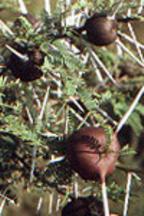

Common Name: Whistling
Thorn, Swollen Thorn Acacia
Genus: Acacia
Species: dreparalobium

The whistling thorn is an acacia tree commonly seen on the savannas of equatorial East Africa, particularly the Serengeti plain.
This acacia can grow about 18 feet tall, but is often stunted in its growth. The whistling thorn acacia protects itself with pairs of long thorns up to 3 inches long. Interspersed with these are modified thorns, called stipular spines, which are joined at the base by hollow bulbous swellings about 1 inch in diameter. These are home to four different kinds of stinging ants who pierce these swollen thorns with tiny holes. When the wind blows it turns old and abandoned spines into tiny whistling flutes, which gives the tree its name.
It isn't clear yet whether the relationship with ants is a symbiotic or parasitic one. This particular acacia doesn't have the toxic chemicals that ward off insects and browsers like other species of acacias do. The stinging ants protect the tree by swarming out of their nests and attacking an intruder at the smallest movement. Giraffes and other browsers are thought to be able to detect the pheromones the ants give off, and leave the tree alone.
However, some ant species, like Crematogaster nigriceps, will prune the branches and flowers of their whistling thorn so that enemy ant colonies on other trees can't get to their tree. This pruning stimulates the acacia to produce a sugary secretion at the ends of their leaflets which feeds the ants. Unfortunately, it also kills the tree's growth tips and effectively sterilizes it so it can't propogate itself.
It is believed that the ants have developed the habit of living in trees because the soil of the savanna turns spongy in the rainy season and dries out and cracks in the dry season. This makes it very difficult for ant to build nests under ground.
The whistling thorn acacia, like other acacias, has developed several ways to survive the severely hot and dry climate in which it lives. Because of the heat the tree must find ways to conserve moisture. Their leaves have evolved into many tiny leaflets (pinnae) which can turn to absorb sunlight, or avoid it and reduce transpiration. The many leaflets are also beneficial when animals graze on them. Some will be left behind to continue the vital task of photosynthesis.
During the dry season on the savanna, the whisling thorn acacia will drop its leaves to conserve water. At the beginning of the rainy season fragrant creamy-white flowers bloom before the leaves grow back. The flowers look like little puffballs and resemble those of the cultivated mimosa tree, which are in the same family. Long seed pods develop, whose seeds are very nutritious and a favorite of many animals, including humans.
2000.
Bibliography:
"Ants x Acacias", http://www.anthro.ucdavis.edu/features/stp/stpants.htm, (July 2000).
"Acacias", http://daphne.palomar.edu/wayne/plaug99.htm, (July 2000).
"african savannahs and wildlife", http://www.wildwatch.com/backissues/sep2000/features/default.htm
Web, David. (1993) Academic American Encydlopedia Volumes 17S Danbury, Connecticut Grolier Inc.
Weigel, Marlene. (2000) UXL Encyclopedia of Biomes 2 Boston Gale Group.
(1998) The New Encyclopedia Britannica Volume 1. Chicago, Britannica Inc.